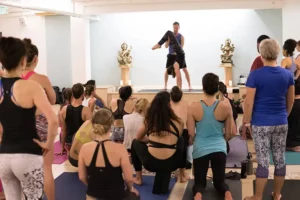Lotus Pose (Padmasana) is one you were likely familiar with before you ever set foot in a yoga studio. Surely you’d seen sculptures of Siddartha or photographs of Indian sadhus with their legs tightly folded together in a pretzel shape. It’s a pose that’s associated with serene states of meditation — and the shape of the pose really does encourage quiet.
Perhaps the tranquil look of the pose is what makes us all pine for it. But make no mistake — it’s not to be attempted lightly. It requires an enormous amount of flexibility in the hip joint and if your body just doesn’t “go there,” you risk hurting your knees.
In the meantime, you can get many benefits with a sequence that prepares you for Lotus. And if your body is ready to fold into the pose, you will know. (Trust me on this.) There will be no knee pain, no stress, no sense of prying or leveraging or forcing. Instead, it will feel like you are folding yourself into the pose.
Forcing your body into Lotus Pose is not worth it in the long run. Pain in your knees or your hips is a sign to back off. Got it? Good.
Most students make the same mistake when they open their hips for Lotus Pose: They focus on stretching the outer hips but forget to open the other muscle groups that make up the hip joint. While the outer hips usually need plenty of help, the key to freedom and balance in your hips is working with all the muscle groups that affect the joint, not just your external rotators. I can’t promise you a Lotus, but practicing the following sequence will make your hips be happier, healthier, and more supple as you work toward it.
If you want to make this sequence a stronger, sweatier flow practice, feel free to practice several Sun Salutations first. You can also add standing poses, arm balances, and inversions to increase the intensity of this practice.
If you’re in need of a quieter, more contemplative practice, you can finish with seated meditation or pranayama.
Hold each pose in the sequence for at least 5 breaths and be sure to practice both sides before attempting Lotus Pose.
{illustrations by MCKIBILLO}
Want more sequences by Jason?
Sign up to join our newsletter and we’ll send you our e-book:
30 Essential Home Practice Sequences.



